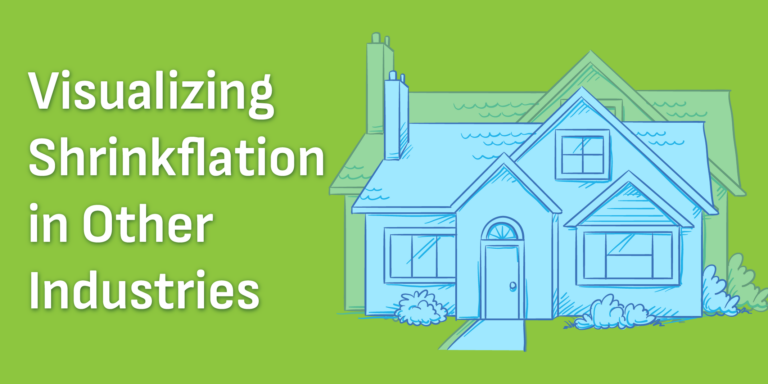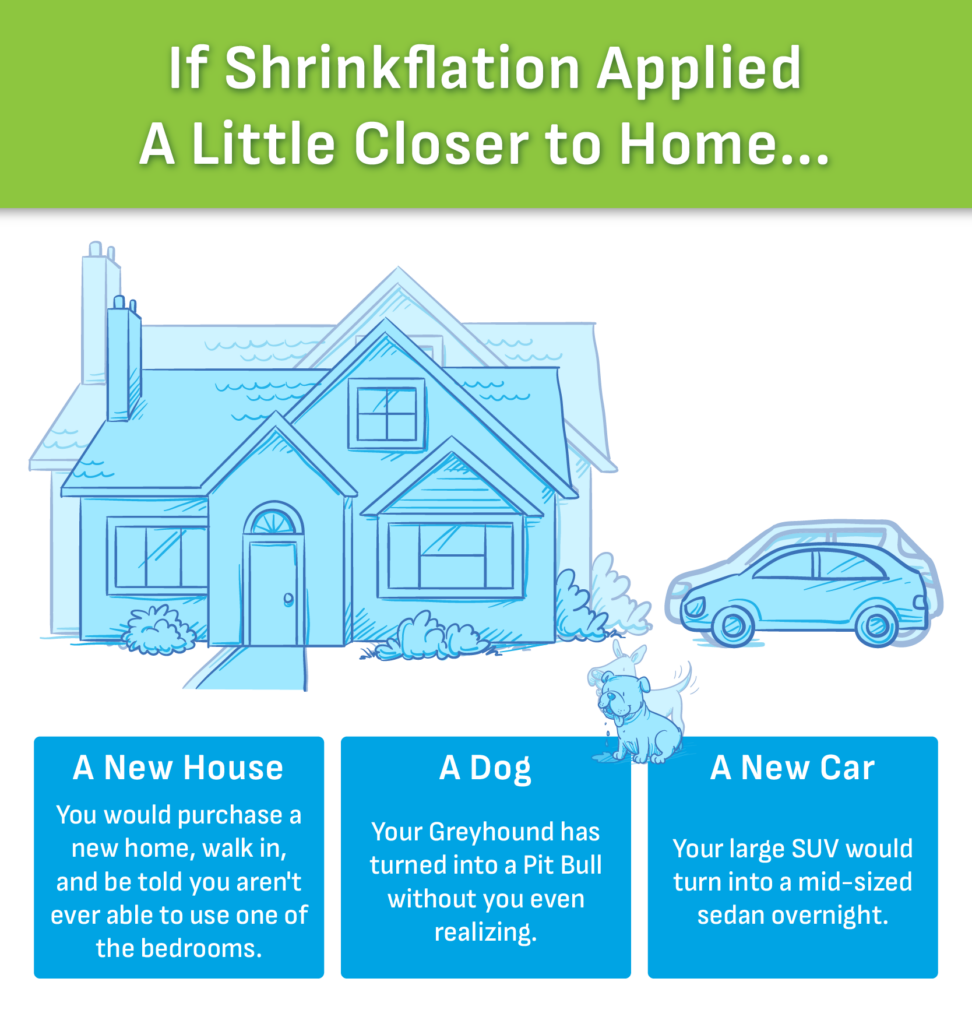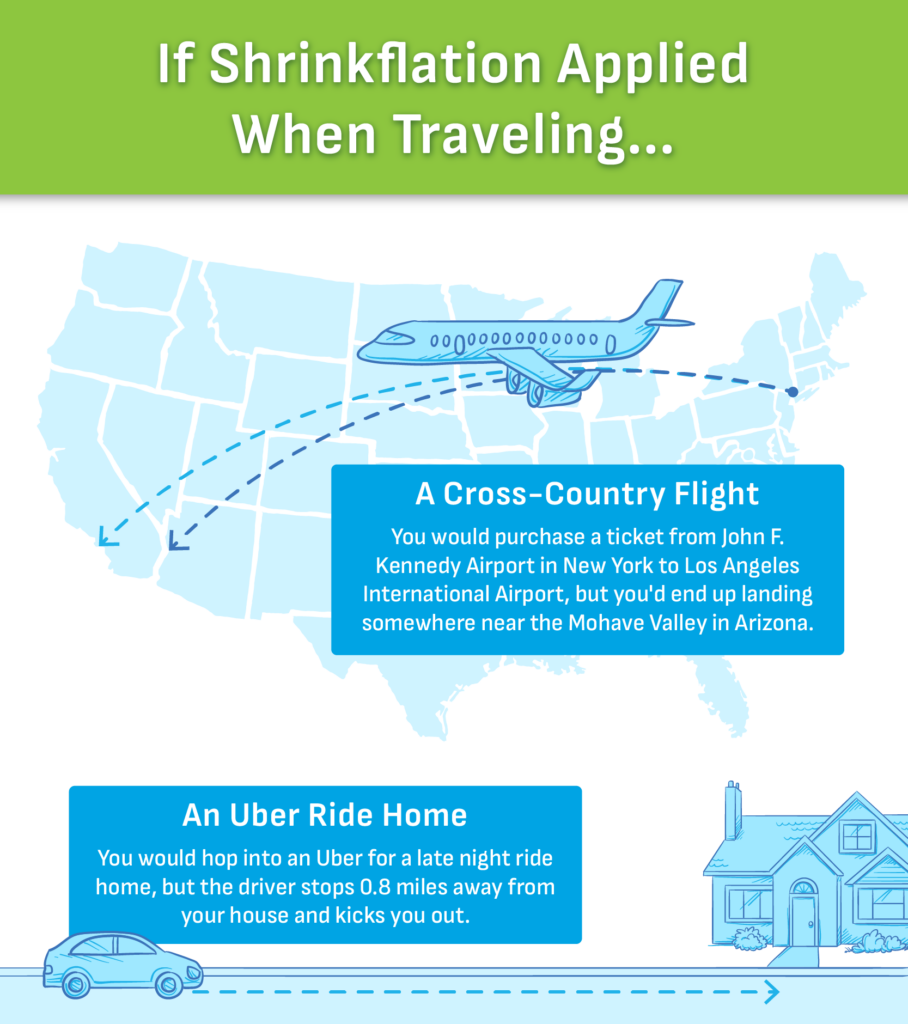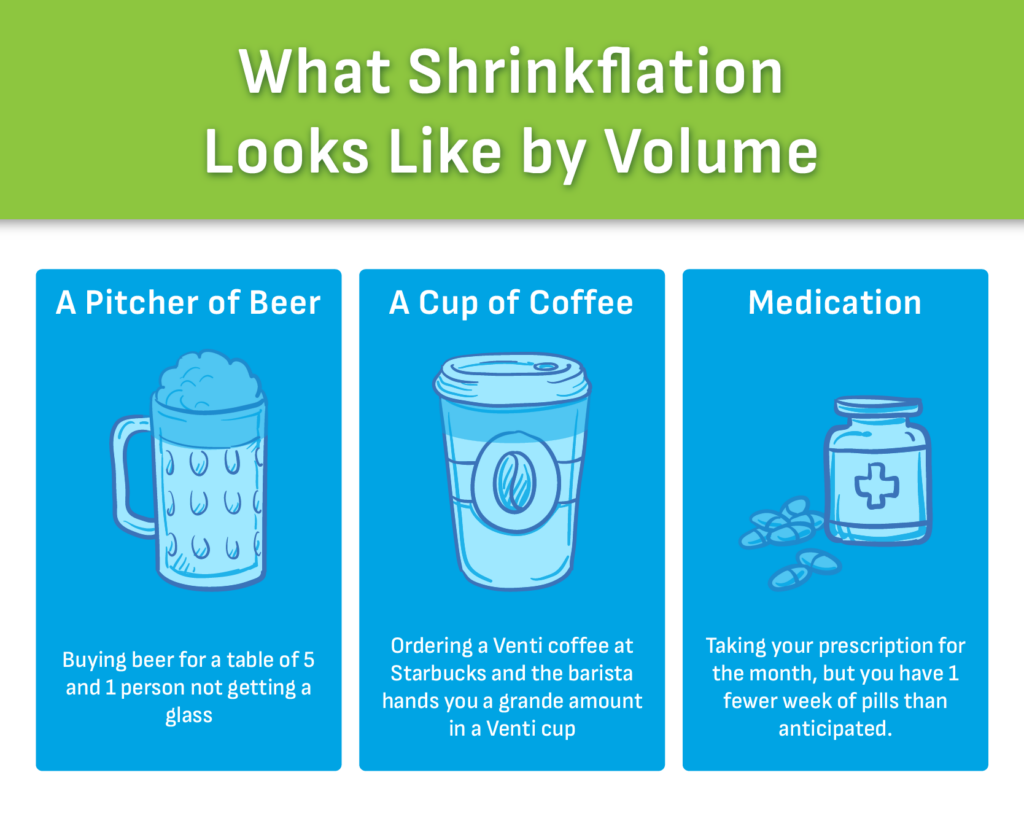
Inflation impacts Americans everywhere from the online shopping cart to the checkout line at their local grocery store but increased costs aren’t the only concern.
One way that companies combat the impact of rising prices on their profit margins is through a process called shrinkflation, which is when the quantity of a product you’re buying is lessened while the packaging and price stay the same (or slightly increase).
It’s a practice that is most commonly seen in the grocery store aisle when things like bags of chips or toothpaste suddenly have less in them than your last trip. That got us thinking, what would shrinkflation look like if it applied on a larger scale? We’re going to apply the practice of shrinkflation to major purchases to see just how much less we’d get when buying things like a new house, a new car, and even a cross-country flight.
To do this, we’ve calculated an average shrinkflation product reduction of 11.84%, based on product reduction estimations of consumer goods from websites like World Economic Forum and Investor Place. Read on to see shrinkflation’s impact on a larger scale!
What Would Shrinkflation Look Like at Home?

First, we’re going to focus on what shrinkflation would look like if it applied at home. Specifically, to things like a house, a car, and a dog.
The average home in the U.S. costs about $348,000 and is 2,356 sq ft. If our average shrinkflation percentage were applied, you’d be paying the same amount but only able to use 2,077 sq ft. That would be like walking into your new home only to realize that one of the bedrooms (which averages about 200 sq ft.) is boarded off!
Large SUVs are about 16.7 ft long, so a size reduction of 12% would result in the vehicle being closer to 14.7 ft. So when applying the idea of shrinkflation to a car, it would be kind of like purchasing a new large SUV but driving off the lot in a mid-sized Sedan instead. If you’re someone who wants a large cabin, that could cause some issues.
No home is complete without a furry friend, so we figured we’d finish up this section by applying shrinkflation to a new dog, too! The average Greyhound grows up to weigh about 70 lbs. If shrinkflation applied, you’d have a dog that weighs about 62 lbs instead. That would be similar to picking up a Greyhound puppy, but having it grow up to become a Pit Bull. Both are great options — just not what you paid for!
What Would Shrinkflation Look Like if It Applied to Travel?

Next, we’ll take a look at shrinkflation through the lens of travel.
A cross-country flight (from JFK to LAX) is about 2,469 mi. If shrinkflation took place when booking your ticket, your flight would only take you 2,177 mi. That’s like boarding the plane in Queens, New York destined for Los Angeles, California but ending up somewhere in the Mohave Valley in Arizona, leaving you to find transportation for the last 300 or so miles of the trip.
Another example hits a little closer to home. If Uber decided it was going to reduce its services by our average shrinkflation percentage, your trip would be about 12% shorter than what you paid for. The average Uber ride is about 7 mi. That means that you’d be hopping into an Uber for a late-night ride home, but the driver stops 0.8 mi away from your house and kicks you out, forcing you to walk the last mile.
Shrinkflation’s Impact by Volume

Our final set of visualizations looks at shrinkflation in a much more familiar setting: products, like coffee and beer, shrinking down by volume.
A pitcher of beer is 60 oz 12% less beer would be just under 53 oz. That would be like buying beer for a table of five and one person not getting a pint. Or, ordering a venti coffee and the barista hands you a venti cup, but it’s filled up to a grande pour.
Lastly, if our average shrinkflation percentage took its toll on medication the impact would be extreme. If you had a 60-capsule prescription, it would only have 53 capsules in it. That would mean that you’d think you had a two-month supply of medicine only to realize that you were short one full week.
Shrinkflation’s Impact on Entertainment
Finally, we decided to see how shrinkflation would impact the entertainment industry. One easy example? Buying a 65-inch TV, but when you turn it on, you can only see about 57 inches of the screen!
Let’s pretend you then decide to put on the award-winning movie, The Sixth Sense. Just before you discover the truth about Dr. Crow (played, of course, by Bruce Willis), the film cuts to black. With shrinkflation shaving about 13 minutes off the runtime, the movie would end just as Cole explains to Lynn that he can see dead people—an iconic line to be sure, but hardly the ending.
For bookworms, an apt comparison would be reading Gillian Flynn’s thriller Gone Girl, and having the book end in the middle of page 370 out of 419. That’s almost 50 pages and a major plot twist you’d never get to experience!
Closing Thoughts
Shrinkflation means that spending the same amount won’t get you as much as it used to. It’s how consumer goods companies deal with increased costs on their end, but it’s important to note when you head out to buy your favorite brands.
With rising costs and decreases in product sizes, Americans will be shaking their piggy banks to keep up. One way for Americans to get more disposable income is to sell their unused life insurance policy through Coventry Direct. We are committed to helping individuals supplement retirement income so they can save for the adventures ahead (or just cover the increasing costs at the check-out line!).
Methodology
To determine what shrinkflation would look like in other industries, we pulled product size reduction data from websites like the World Economic Forum and Investor Place to find the average size reduction we can expect from shrinking product sizes.
With this average, we compared it to large purchases and common services to better visualize what it would look like if other industries followed a similar path that consumer goods do to combat their losses from inflation. We analyzed how much less of a house and car you would be purchasing, as well as how much shorter a distance you would be traveling for the same prices you would be paying today.

